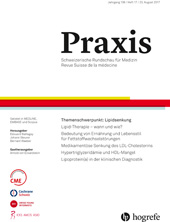Abstract
Zusammenfassung. Die Dyslipidämie stellt einen der wichtigsten kardiovaskulären Risikofaktoren dar. Massnahmen dagegen sind deshalb von zentraler Bedeutung. Die Behandlung erhöhter Lipidwerte mit Statinen hat sich dabei als besonders erfolgreich erwiesen. Die Indikation zur lipidsenkenden Therapie richtet sich nach dem kardiovaskulären Risiko. Patienten, die bereits an atherosklerotischen Krankheiten oder Niereninsuffizienz leiden, bzw. an Diabetes Typ 1 mit Organschäden oder Typ 2 mit weiteren Risikofaktoren, oder solche mit familiärer Hypercholesterinämie, gelten als Hochrisikopatienten und sollten entsprechend behandelt werden. Bei allen übrigen empfiehlt sich die Berechnung des 10-Jahres-Risikos. In der Schweiz werden gewöhnlich der modifizierte PROCAM-Score/Algorithmus der AGLA und der Score der EAS/ESC verwendet. Die Intensität der Behandlung hängt vom kardiovaskulären Risiko ab.
Abstract. Dyslipidaemia is one of the most important cardiovascular risk factors. Measures to treat it therefore are of central importance. The treatment of elevated lipid values with statins has proven particularly successful. The indication for lipid-lowering therapy is based on the cardiovascular risk. Patients who have already an atherosclerotic disease, a renal insufficiency or diabetes type I with organ damage or type II with further risk factors, or those with familial hypercholesterolemia, are considered to be high-risk patients and should be treated accordingly. For all others, the calculation of the 10-year risk is recommended. In Switzerland, the modified PROCAM score/algorithm of the AGLA and the score of the EAS/ESC are usually used. The intensity of the treatment depends on the cardiovascular risk.
Résumé. La dyslipidémie est l’un des facteurs de risque cardiovasculaire les plus importants. Les mesures de son traitement sont donc d’une importance capitale. Le traitement de l’hyperlipidémie avec des statines s’est avéré particulièrement efficace. L’indication pour le traitement hypolipémiant est basée sur le risque cardiovasculaire. Les patients qui souffrent déjà d’une maladie athérosclérotique, d’une insuffisance rénale ou d’un diabète de type I avec des lésions d’organes ou de type II avec d’autres facteurs de risque, ou ceux atteints d’hypercholestérolémie familiale sont des patients à haut risque et devraient être traités en conséquence. Dans tous les autres le calcul du risque de 10 ans est recommandé. En Suisse, le score/algorithme modifié de PROCAM de l’AGLA et le score de l’EAS/ESC sont habituellement utilisés. L’intensité du traitement dépend du risque cardiovasculaire.
Bibliografie
Cholesterol Treatment Trialists’ (CTT) Collaboration : Baigent C, Blackwell L, Emberson J, et al.: Efficacy and safety of more intensive lowering of LDL cholesterol: a meta- analysis of data of 170000 participants in 26 randomised trials. Lancet 2010; 376: 1670–1681., : Ezetimibe added to statin therapy after acute coronary syndromes. N Engl J Med 2015; 372: 2387–2397.
;
PCSK9 Forum : PCSK9 inhibitors and cardiovascular disease: heralding a new therapeutic era. Curr Opin Lipidol 2015; 26: 511–520., : Evolocumab and clinical outcomes in patients with cardiovascular disease. 2017; 376: 1713–1722.
: Statine zur Primärprävention kardiovaskulärer Erkrankungen. Schweiz Ärztezeitung 2014; 95: 1084–1087.
AGLA-Risikoalgorithmus : www.agla.ch. Letzter Zugriff: 24.5.2017., : For the SCORE project group. Estimation of ten-year risk of fatal cardiovascular diesease in Europe: the SCORE project. Eur Heart J 2003; 24: 987–1003.
: Prediction of first coronary events with the Framingham score: a systematic review. Am Heart J 2007; 153: 722–731.
, : 2013 ACC/AHA guidelines on the treatment of blood cholesterol to reduce atherosclerotic risk in adults: a report of the American College of Cardiology/American Heart Association Task Force on Practice Guidelines. Circulation 2014; 129: S1-S45.
, : Diagnostic yield and clinical utility of sequencing familial hypercholesterolemia genes in patients with severe hyperlipidemia. J Am Coll Cardiol 2016; 67: 2578–2589.
, : Treat-to-traget versus dose-adapted statin treatment of cholesterol to reduce cardiovascular risk. Eur J Prev Cardiol 2016; 23: 275–281.
, : Comparison of the efficacy and safety of rosuvastatin versus atorvastatin, simvastatin, and pravastatin across doses (STELLAR* Trial). Am J Cardiol 2003; 2: 152–180.
, : Efficacy and safety of ezetimibe added to ongoing statin therapy for treatment of patients with primary hypercholesterolemia. Am J Cardiol 2002; 90: 1084–1091.



